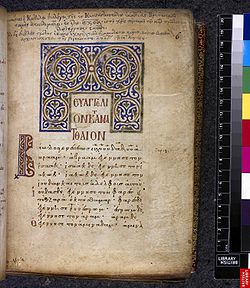- Minuscule 65
-
New Testament manuscripts
papyri • uncials • minuscules • lectionariesMinuscule 65
The first page of the Gospel of MatthewName Codex Ussher 2
Harleianus 5776Text Gospels Date 11th century Script Greek Found 1674, John Covel Now at British Library Size 22.8 cm by 17.8 cm Type Byzantine text-type Category V Note marginalia Minuscule 65 (in the Gregory-Aland numbering), ε 135 (von Soden),[1] formerly known as Ussher 2, is a Greek minuscule manuscript of the New Testament, on parchment leaves. Palaeographically it has been assigned to the 11th century.[2] The manuscript has complex contents, it has marginalia.
Contents
Description
The codex contains a complete text of the four Gospels on 309 leaves (size 22.8 cm by 17.8 cm).[2] The last verse in Gospel of John was supplied by a later hand.[3] The text is written in one column per page, 22 lines per page.[2][4] The decorated head-pieces at the beginning of each Gospel. Four initial letters in colour and gold (at the beginning of each Gospel).
The text is divided according to the κεφαλαια (chapters), whose numbers are given at the margin, and their τιτλοι (titles of chapters) at the top of the pages. There is also another division according to the smaller Ammonian Sections (in Matthew 355, Mark 234 - 16:9, Luke 342, John 232 sections), whose numbers are given at the margin with references to the Eusebian Canons (written below Ammonian Section numbers).[4]
It contains the Epistula ad Carpianum, the Eusebian Canon tables at the beginning, tables of the κεφαλαια (tables of contents) before each Gospel, subscriptions at the end of each Gospel, with numbers of στιχοι.[4][3] There are some notes made by later hand at the margin.
Text
The Greek text of the codex is a representative of the Byzantine text-type. Aland placed it in Category V.[5] It is a member of the textual family E (Soden's Ki). According to the Claremont Profile Method it represents the textual family Kx in Luke 1, Luke 10, and Luke 20.[6]
John 5:3.4 is marked by an obelus.[4]
History
Minuscule 446 probably was rewritten from this manuscript.
In 1674 archbishop of Proconesus presented this manuscript to John Covel (1637-1722), British chaplain in Constantinople, and in 1677 it came to England along with minuscule 110. The manuscript was brought by Covel from Sinai to England (along with minuscule 110).[7] Then the manuscript belonged to Robert Harley, and to his son Edward Harley.[8] In 1753 it was purchased along with other manuscripts of collection by the British Museum.
The manuscript was examined by John Mill (as Cov. 1) and Griesbach.[4] Griesbach gave for it number 167 on his list. C. R. Gregory saw it in 1883.[4]
It is currently housed at the British Library as a part of the Harleian Collection (5776), at London.[2]
See also
References
- ^ Gregory, Caspar René (1908). Die griechischen Handschriften des Neuen Testament. Leipzig: J. C. Hinrichs'sche Buchhandlung. p. 50. http://www.archive.org/stream/diegriechischen00greggoog#page/n61/mode/2up.
- ^ a b c d K. Aland, M. Welte, B. Köster, K. Junack, "Kurzgefasste Liste der griechischen Handschriften des Neues Testaments", Walter de Gruyter, Berlin, New York 1994, p. 50.
- ^ a b Scrivener, Frederick Henry Ambrose; Edward Miller (1894). A Plain Introduction to the Criticism of the New Testament. 1 (4 ed.). London: George Bell & Sons. p. 202.
- ^ a b c d e f Gregory, Caspar René (1900). Textkritik des Neuen Testaments. 1. Leipzig: Hinrichs. p. 144. http://www.archive.org/stream/textkritikdesne00greggoog#page/n157/mode/2up.
- ^ Aland, Kurt; Barbara Aland; Erroll F. Rhodes (trans.) (1995). The Text of the New Testament: An Introduction to the Critical Editions and to the Theory and Practice of Modern Textual Criticism. Grand Rapids: William B. Eerdmans Publishing Company. p. 138. ISBN 978-0-8028-4098-1.
- ^ Wisse, Frederik (1982). The profile method for the classification and evaluation of manuscript evidence, as Applied to the Continuous Greek Text of the Gospel of Luke. Grand Rapids: William B. Eerdmans Publishing Company. p. 54. ISBN 0-8028-1918-4.
- ^ Gregory, Caspar René (1900). Textkritik des Neuen Testaments. 1. Leipzig: Hinrichs. p. 265–266. http://www.archive.org/stream/textkritikdesne00greggoog#page/n277/mode/2up.
- ^ Michaelis, Introduction to the New Testament (London 1823), p. 735.
Further reading
- Cyril Ernest Wright, Fontes Harleiani: A Study of the Sources of the Harleian Collection of Manuscripts in the British Museum (London: British Museum, 1972), p. 116.
- See bibliography to the Family E
External links
- Codex Harleianus 5776 at the British Library
Categories:- Greek New Testament minuscules
- 11th-century biblical manuscripts
- Harleian Collection
Wikimedia Foundation. 2010.

